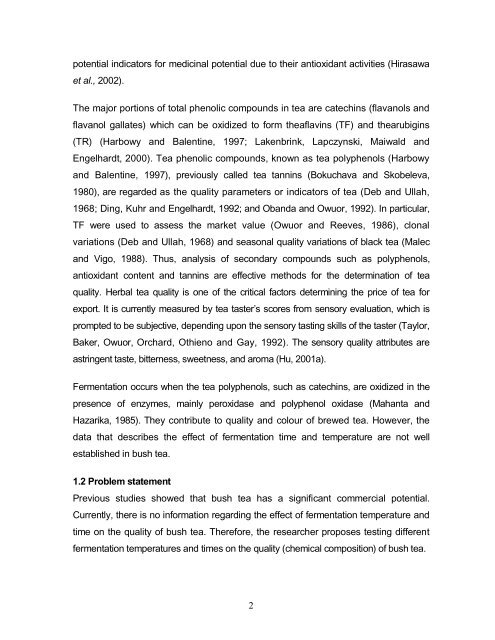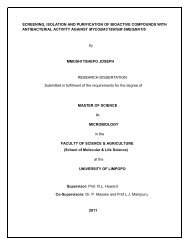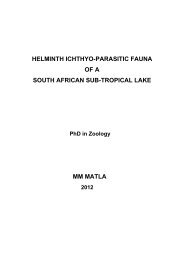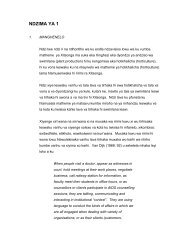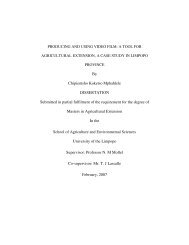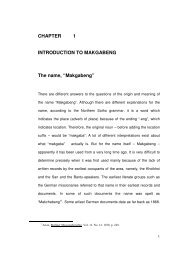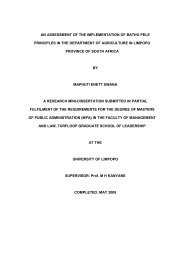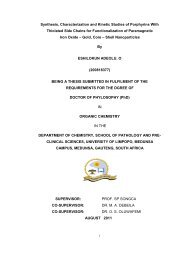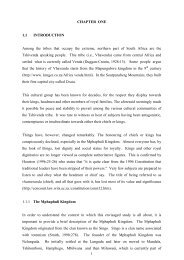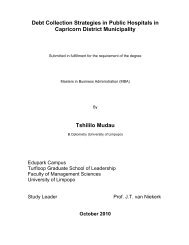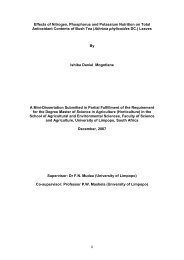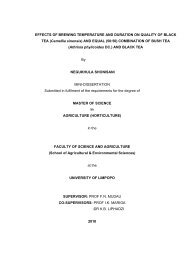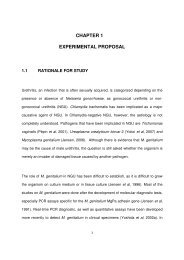Hlahla LN Mini-Dissertation.pdf - University of Limpopo Institutional ...
Hlahla LN Mini-Dissertation.pdf - University of Limpopo Institutional ...
Hlahla LN Mini-Dissertation.pdf - University of Limpopo Institutional ...
You also want an ePaper? Increase the reach of your titles
YUMPU automatically turns print PDFs into web optimized ePapers that Google loves.
potential indicators for medicinal potential due to their antioxidant activities (Hirasawa<br />
et al., 2002).<br />
The major portions <strong>of</strong> total phenolic compounds in tea are catechins (flavanols and<br />
flavanol gallates) which can be oxidized to form theaflavins (TF) and thearubigins<br />
(TR) (Harbowy and Balentine, 1997; Lakenbrink, Lapczynski, Maiwald and<br />
Engelhardt, 2000). Tea phenolic compounds, known as tea polyphenols (Harbowy<br />
and Balentine, 1997), previously called tea tannins (Bokuchava and Skobeleva,<br />
1980), are regarded as the quality parameters or indicators <strong>of</strong> tea (Deb and Ullah,<br />
1968; Ding, Kuhr and Engelhardt, 1992; and Obanda and Owuor, 1992). In particular,<br />
TF were used to assess the market value (Owuor and Reeves, 1986), clonal<br />
variations (Deb and Ullah, 1968) and seasonal quality variations <strong>of</strong> black tea (Malec<br />
and Vigo, 1988). Thus, analysis <strong>of</strong> secondary compounds such as polyphenols,<br />
antioxidant content and tannins are effective methods for the determination <strong>of</strong> tea<br />
quality. Herbal tea quality is one <strong>of</strong> the critical factors determining the price <strong>of</strong> tea for<br />
export. It is currently measured by tea taster’s scores from sensory evaluation, which is<br />
prompted to be subjective, depending upon the sensory tasting skills <strong>of</strong> the taster (Taylor,<br />
Baker, Owuor, Orchard, Othieno and Gay, 1992). The sensory quality attributes are<br />
astringent taste, bitterness, sweetness, and aroma (Hu, 2001a).<br />
Fermentation occurs when the tea polyphenols, such as catechins, are oxidized in the<br />
presence <strong>of</strong> enzymes, mainly peroxidase and polyphenol oxidase (Mahanta and<br />
Hazarika, 1985). They contribute to quality and colour <strong>of</strong> brewed tea. However, the<br />
data that describes the effect <strong>of</strong> fermentation time and temperature are not well<br />
established in bush tea.<br />
1.2 Problem statement<br />
Previous studies showed that bush tea has a significant commercial potential.<br />
Currently, there is no information regarding the effect <strong>of</strong> fermentation temperature and<br />
time on the quality <strong>of</strong> bush tea. Therefore, the researcher proposes testing different<br />
fermentation temperatures and times on the quality (chemical composition) <strong>of</strong> bush tea.<br />
2


